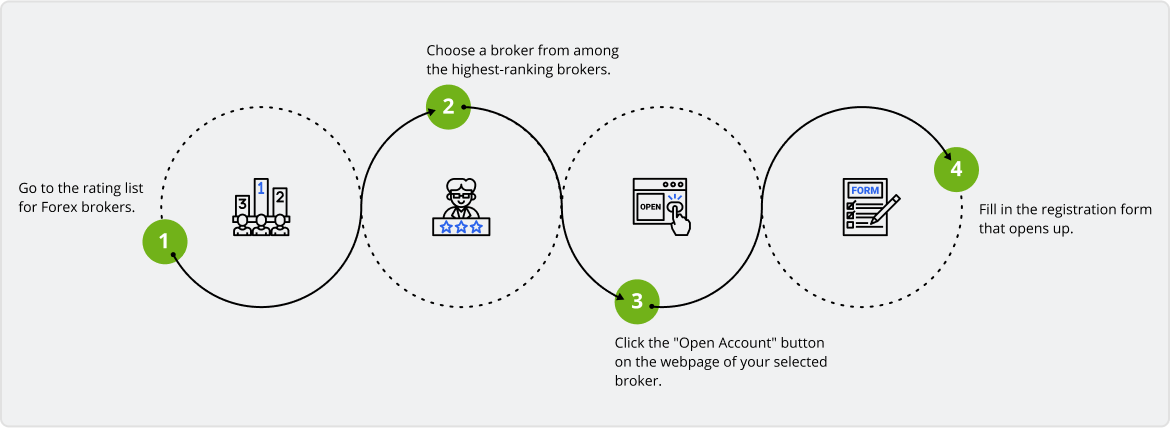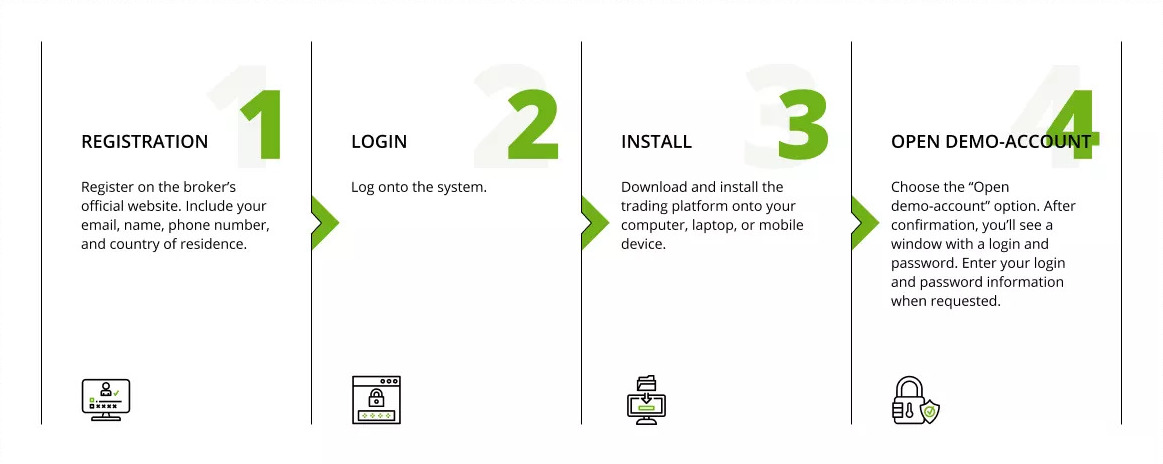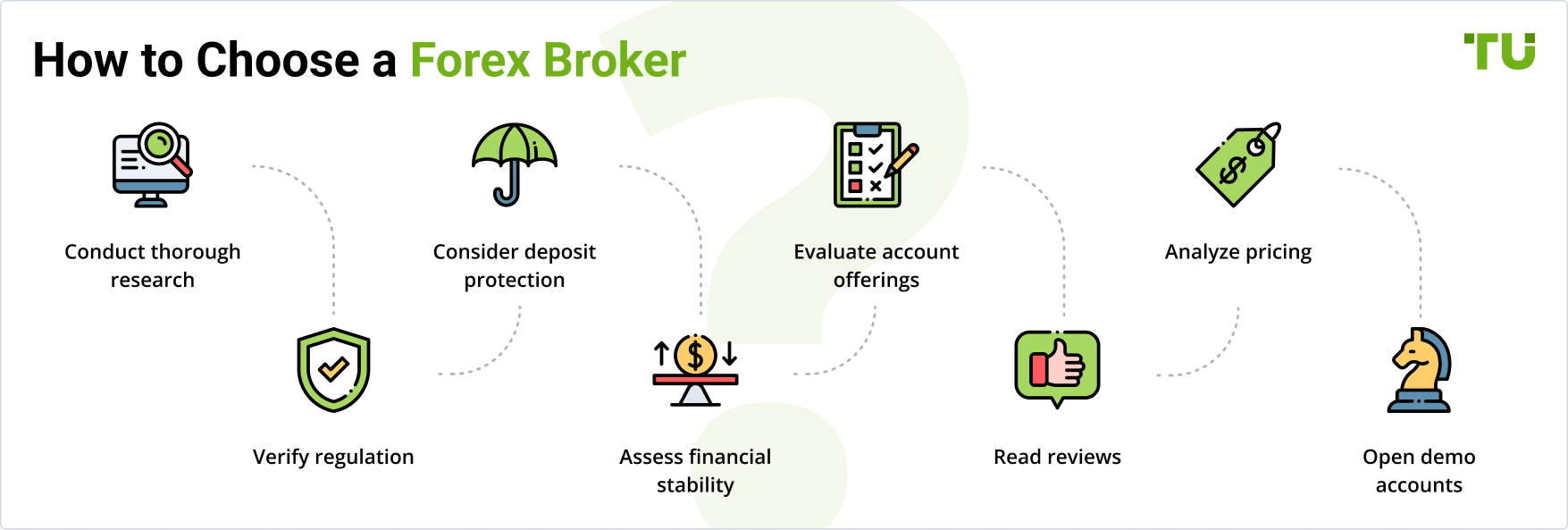How to open a Forex trading account? Beginner guide



Editorial Note: While we adhere to strict Editorial Integrity, this post may contain references to products from our partners. Here's an explanation for How We Make Money. None of the data and information on this webpage constitutes investment advice according to our Disclaimer.
To open a trading account, follow these steps:
Choose a reputable broker
Register on the broker's official website
Log in to your personal account
Select the type of real account
Make a deposit
Fund your account
Begin trading
Opening a Forex trading account can seem totally bewildering for newbie traders. Broker types, minimum deposits, platforms—it's enough jargon to make your head spin! But taking the plunge into currency trading doesn't have to be so scary.
In this guide, we'll hold your hand through the entire account opening process, from choosing the right broker to funding your shiny new account. You'll learn insider tips to pick a trustworthy broker that matches your trading style. We'll decode the difference between a standard account and options like mini and managed accounts. And we'll even reveal the easiest funding methods so you can start trading currencies in no time.
Whether you dream of diving into volatile currency pairs or prefer steady long-term positions, you'll discover how to tailor an approach that fits.
Follow this roadmap and soon you’ll go from Forex newbie to savvy currency trader equipped to build your wealth in the global marketplace.
How to open a Forex real account
To begin your journey in Forex trading by opening a real account, follow these step-by-step instructions:
Step 1: Choose a reputable broker
The first crucial step is to select a reliable broker that aligns with your trading needs and preferences. Conduct thorough research, considering factors such as regulation, trading platforms, customer support, fees, and available trading instruments.
Step 2: Register on the broker's official website
Once you've chosen a suitable broker, proceed to their official website and locate the registration form. Provide the necessary personal information, including your name, email address, phone number, and any other required details. Fill out the form accurately and submit it.
Step 3: Log in to your personal account
After successful registration, you will receive login credentials (username and password) via email or directly on the website. Use these credentials to log in to your personal account on the broker's website.
Step 4: Select the type of real account
Within your personal account, you will typically find a list of different account types offered by the broker. Evaluate the features and benefits of each account type and choose the one that suits your trading goals and financial capabilities. Once decided, click on the "Open Account" option corresponding to your chosen account type.
Step 5: Make a deposit
To commence trading, you need to deposit funds into your newly opened real account. Determine your starting budget based on your risk tolerance and financial resources. Brokers usually provide various deposit methods, such as bank transfers, credit/debit cards, and electronic wallets. At the same time, some Forex brokers offer instant deposits, allowing you to quickly fund your account and respond to changing market conditions. Select the most convenient option for you and follow the instructions to make the deposit.
Step 6: Fund your account
After completing the deposit, the funds will be credited to your real trading account. This process may take some time, depending on the chosen deposit method and the broker's policies. Once the funds are successfully credited, you are ready to start trading.
Step 7: Begin trading
Now that your real account is set up and funded, you can access the trading platform provided by the broker. The most commonly used platforms are MetaTrader 4 (MT4) and MetaTrader 5 (MT5). Enter the provided login and password in the trading platform to gain access. It is advisable to change your password for security purposes upon the first login.
Choosing an expert-suggested broker
 Pros and cons of prop trading
Pros and cons of prop tradingThe experts at TU have researched numerous brokers to create a dedicated list of the best brokers as per your need. Here’s what you can do to take advantage of the same:
Step 1: Go to the rating list for the brokers
Head to the rating list for top Forex brokers prepared by TU experts. Study and understand the offerings of each one of them.
Step 2: Choose a broker from among the highest-ranking brokers
After considering all the information, choose one of the top brokers from the list for opening your account.
Here are three brokers with the highest ratings that accept investors from your country according to Traders Union's methodology.
| Min. deposit, $ | Supported currency pairs | Spread EUR/USD | Commission ($, per lot) | TU overall score | Open account | |
|---|---|---|---|---|---|---|
| 100 | 60 | No | No | 6.83 | Open an account Your capital is at risk. |
|
| No | 90 | 0,1 | 3 | 7.17 | Open an account Your capital is at risk.
|
|
| No | 68 | 0,15 | 3,5 | 6.8 | Open an account Your capital is at risk. |
Step 3: Click the “Open Account” button on the webpage of your selected broker
Head to the selected brokers website and begin the account opening process.
Step 4: Fill in the registration form that opens up
Navigate through the registration form and provide the required information. Complete the verification process, upload necessary documents and your trading account will be ready to be used. Make sure you deposit sufficient funds for trading your respective strategy.
Forex account types explained
When venturing into Forex trading, understanding the different Forex trading account types is crucial. The experts have explored the distinct features and advantages of each account type, along with minimum deposit requirements and fee structures.
Real Forex Account Types:
Standard (Classic) Account:
Formerly the most popular choice, the Standard account, also referred to as Classic, remains relevant in the Forex market. Traders who value stability often opt for this account type, thanks to its fixed spread.
- Advantages
- Offers higher quote accuracy
- Provides market execution of orders
- Eliminates requotes
- No Stop or Limit levels
- Allows for high leverage, up to 1:1,000
- Requires a low minimum deposit, typically starting at $50
Fee Structure:
The Standard account typically does not charge commissions but may have a minimum spread of around 0.6 pips. This wider spread simplifies cost calculations, as there is no commission involved.
Mini Account:
Designed for traders with limited capital, the Mini account offers a reduced deposit requirement while maintaining standard trading conditions.
- Advantages
- Gradual transition to real-money trading
- Lower risk exposure
- Comparable order execution to other account types
- Well-suited for testing trading platforms
- Often used in the PAMM system to showcase yield curves
Minimum Deposit:
Most Mini accounts can be opened with a minimum deposit ranging from $250 to $500, granting leverage of up to 400:1.
Cent Account:
The Cent account caters to traders who prefer smaller trade sizes by reducing the deposit requirement significantly.
- Advantages
- Ability to trade nano, micro, and mini lots
- Substantially reduced risk exposure
- Similar order execution to other account types
- Popular for demonstrating yield curves in the PAMM system
- Ideal for testing strategies instead of demo accounts
- Suitable for exploring new instruments and trading CFDs
- Often used for testing trading robots
Minimum Deposit:
Typically, Cent accounts require a minimum deposit ranging from $1 to $10.
Fee Structure:
Cent accounts commonly feature a floating spread starting from 1 pip.
Micro Account:
Micro accounts are tailored to traders with limited trading capital, enabling them to participate in the market with smaller trade sizes.
- Advantages
- Suitable for low-capital accounts, typically between $1,000 and $5,000
- Allows trading in micro lots (1/10th of a mini lot)
- Reduces risk exposure effectively
- No significant differences in order execution
- Provides flexibility in opening smaller positions
- Enables testing and refining of trading strategies
Minimum Deposit:
Many Micro accounts do not impose a minimum deposit requirement. If applicable, the amount is usually modest, such as $50.
Fee Structure:
Micro accounts often have fixed spreads, typically ranging up to a maximum of 5 pips.
RAW (ECN) Account:
ECN accounts offer direct access to the market, facilitating tighter bid/ask spreads and faster market execution.
- Advantages
- Aggregates price quotations from multiple market participants
- Delivers competitive quotes without delays
- Offers a wide range of liquidity providers
- Spreads start as low as -1 pip
- Suited for professional traders with ample capital
- Provides enhanced privacy for traders who value anonymity
Minimum Deposit:
ECN accounts generally require a higher minimum deposit, typically ranging from $200 to $1,000.
Fee Structure:
ECN accounts often feature spreads as low as 0.0 pips on major currency pairs.
What are the best Forex accounts for beginners?
When it comes to Forex trading, beginners are often advised to start with specific account types that offer minimal risks and ample opportunities for practice. In this section, the experts will explore three account types that are particularly well-suited for beginners: demo accounts, cent accounts, and mini accounts.
Demo Accounts:
Forex demo accounts serve as invaluable learning tools for beginners. These accounts provide a simulated trading environment where traders can practice their strategies and familiarize themselves with the trading platform, all without risking real money. Demo accounts typically offer virtual funds, allowing beginners to explore the Forex market and test their skills in a risk-free setting. They provide an excellent opportunity to gain confidence, understand market dynamics, and refine trading techniques before venturing into live trading.
Cent Accounts:
Cent accounts are another favorable option for beginners due to their low-risk nature. These accounts allow traders to trade with smaller contract sizes, such as micro lots or even nano lots, which significantly reduces the monetary value of each trade. With cent accounts, beginners can experience real market conditions and the psychological aspects of trading with a limited investment. This account type is particularly useful for those who want to get a feel for live trading while minimizing their risk exposure. Cent accounts are also popular for testing strategies and exploring new trading instruments.
Mini Accounts:
For beginners looking to start trading with a modest investment, mini accounts are an excellent choice. These accounts typically require a lower minimum deposit compared to standard accounts. With mini accounts, traders can trade in mini lots, which represent 10,000 units of the base currency, rather than the standard 100,000 units. This reduced trade size allows beginners to control their risk more effectively, as each pip movement has a smaller impact on their account balance. Mini accounts provide an opportunity to gain practical experience with real funds and real market conditions while still maintaining a conservative approach.
Demo Trading Account vs Real Trading Account
A demo or so-called training account is the best option to start forex trading. Novice traders can test advisers, indicators, and their own trading strategies on a demo account.
| Account type | The need to invest real money | Ability to make trading transactions | Real trading income | Payments from Traders Union (rebate) |
|---|---|---|---|---|
| Demo | No | Yes | No | No |
| Real | Yes | Yes | Yes | Yes |
How to open a demo account
 How to open a demo account
How to open a demo accountIf you're interested in exploring Forex trading without risking real money, opening a demo account is the way to go. Demo accounts provide a simulated trading environment where you can practice and familiarize yourself with the platform. Here is a step-by-step guide on how to open a demo account on popular trading platforms like MetaTrader 4 (MT4) and MetaTrader 5 (MT5)
Registration:
To get started, visit the broker's website or download the trading platform. Look for the option to create a new account and click on it. You will be prompted to provide your personal information such as name, email address, and phone number. Fill in the required details accurately to complete the registration process.
Login:
After registering, you will receive login credentials, including a username and password. Use these credentials to log in to the trading platform.
Install the trading platform:
If you haven't already installed the trading platform on your device, now is the time to do so. Visit the official website of the platform provider or use the download link provided by your broker. Follow the instructions to install the platform on your computer or mobile device.
Open a Demo Account:
Once you have installed the trading platform and logged in, navigate to the account section. Look for the option to open a new account and select the demo account type. Provide any additional details required, such as your preferred currency and leverage. Then, click on "Open Account" or a similar button to create your demo account.
How to choose a Forex broker
 How to choose a Forex broker
How to choose a Forex brokerSelecting the right Forex broker is a crucial decision that can significantly impact your trading success. To help you navigate this process, here is a step-by-step guide on how to choose a Forex broker:
Conduct thorough research: Begin by conducting extensive research on various Forex brokers to identify the ones that align with your trading requirements and financial capabilities. Utilize resources like Forex broker reviews, comparison sites, and regulatory agency websites to gather relevant information.
Verify regulation: Ensure that the broker you choose is regulated by a reputable regulatory agency in a well-established financial center. This regulatory oversight safeguards the security of your funds.
Consider deposit protection: Opt for a broker whose regulators offer deposit protection for clients. This means that in the event of broker insolvency, the government will reimburse your funds up to a specific amount, providing an added layer of security.
Assess financial stability: Select a broker with a strong financial standing and a positive reputation in the industry. This ensures that the broker possesses the necessary resources to meet their financial obligations to you.
Evaluate account offerings: Compare the account types, trading platforms, tools, and research resources provided by each broker. Look for brokers that offer the features and services that are essential for your specific trading and investment needs.
Read reviews: Dive into detailed Forex broker reviews to assess factors like pricing, product offerings (such as the availability of Forex pairs and CFDs), and overall user experiences. This will help you identify brokers that align with your unique requirements.
Analyze pricing: Compare the trading costs, spreads, and commissions charged by different brokers. Opt for a broker that offers competitive trading fees, efficient trade execution, and a commitment to transparency.
Open demo accounts: Consider Forex brokers with demo accounts. This allows you to experience their platforms firsthand and evaluate trading costs, ultimately aiding you in making an informed decision. Read this article If you are wondering why a broker might block your trading account.
Expert Opinion
To ensure successful registration and account opening with a Forex broker, you need to consider several factors. Firstly, provide only accurate information. Secondly, ensure the correctness of what and how you write. For example, if you make a mistake in your name or taxpayer ID number, it can become a problem later. The third factor is directly related to the first two – verification. Be prepared to provide the necessary documents. Remember that these don't necessarily have to be scans of paper documents. For example, you can confirm your address by requesting a statement through your bank's mobile application. In just a few seconds, you will receive a document that allows you to quickly confirm your residential address.
FAQs
What software or platforms do I need?
Most brokers offer their own proprietary trading platforms or apps, usually available for desktop and mobile devices. Popular third party platforms include MetaTrader 4 and MetaTrader 5.
What are the costs involved in Forex trading?
You'll need to pay broker commissions and bid/ask spreads on each trade. There may also be additional fees for withdrawals, account inactivity etc. Research the full fee structure before opening an account.
Is Forex trading risky?
All investments involve some risk. Have proper risk management rules in place and use stop losses. Don't risk more than you can afford to lose. The high leverage offered in Forex magnifies risk.
Do I need trading experience to get started?
You can open an account as a complete beginner! However, it's highly recommended to educate yourself and practice with a demo account first. Start small when going live trading.
Related Articles
Team that worked on the article
Chinmay Soni is a financial analyst with more than 5 years of experience in working with stocks, Forex, derivatives, and other assets. As a founder of a boutique research firm and an active researcher, he covers various industries and fields, providing insights backed by statistical data. He is also an educator in the field of finance and technology.
As an author for Traders Union, he contributes his deep analytical insights on various topics, taking into account various aspects.

Dr. BJ Johnson is a PhD in English Language and an editor with over 15 years of experience. He earned his degree in English Language in the U.S and the UK. In 2020, Dr. Johnson joined the Traders Union team. Since then, he has created over 100 exclusive articles and edited over 300 articles of other authors.
Mirjan Hipolito is a journalist and news editor at Traders Union. She is an expert crypto writer with five years of experience in the financial markets. Her specialties are daily market news, price predictions, and Initial Coin Offerings (ICO).
Forex indicators are tools used by traders to analyze market data, often based on technical and/or fundamental factors, to make informed trading decisions.
Risk management is a risk management model that involves controlling potential losses while maximizing profits. The main risk management tools are stop loss, take profit, calculation of position volume taking into account leverage and pip value.
Trade execution is knowing how to place and close trades at the right price. This is the key to turning your trading plans into real action and has a direct impact on your profits.
CFD is a contract between an investor/trader and seller that demonstrates that the trader will need to pay the price difference between the current value of the asset and its value at the time of contract to the seller.
Yield refers to the earnings or income derived from an investment. It mirrors the returns generated by owning assets such as stocks, bonds, or other financial instruments.






























































































































